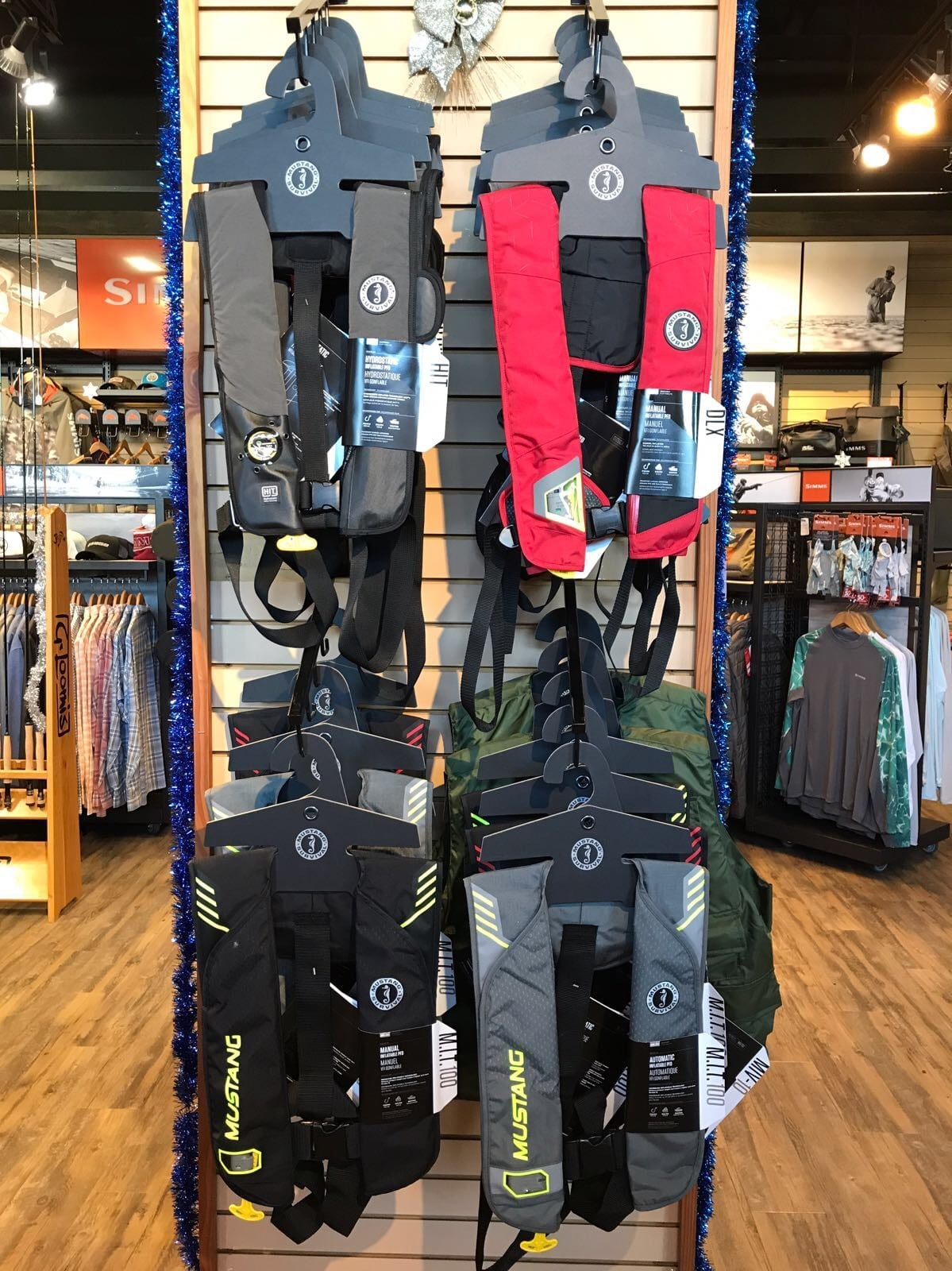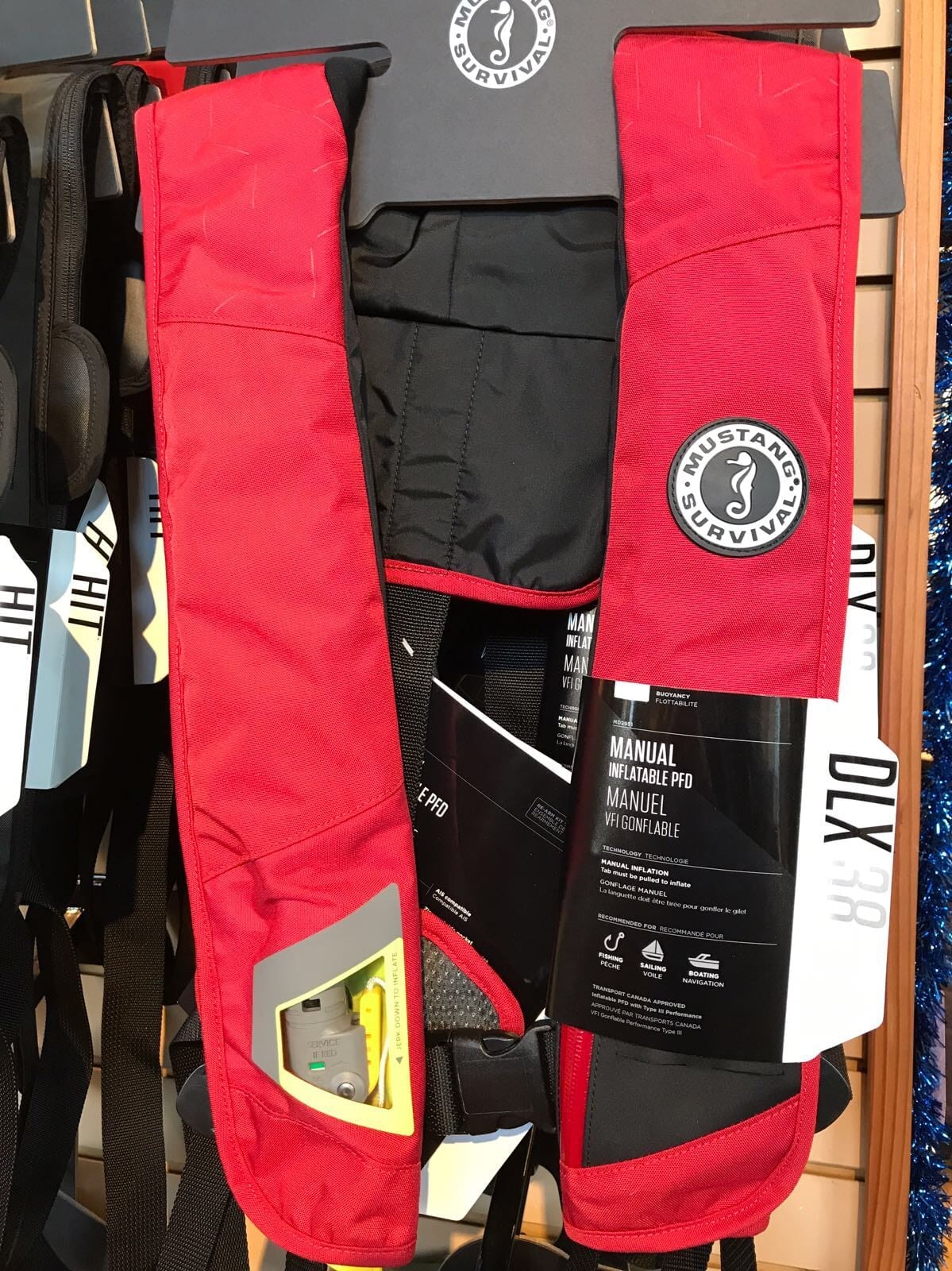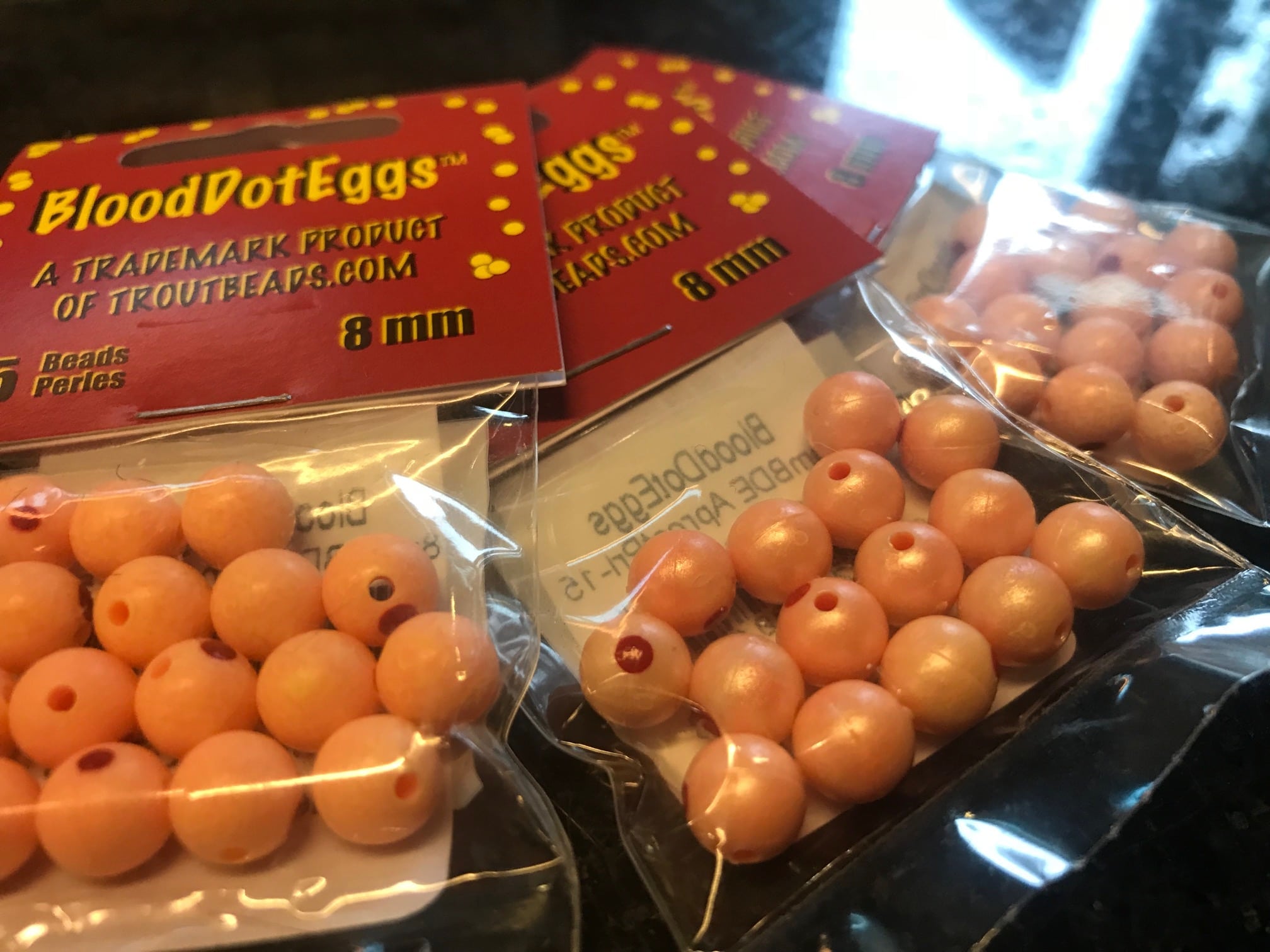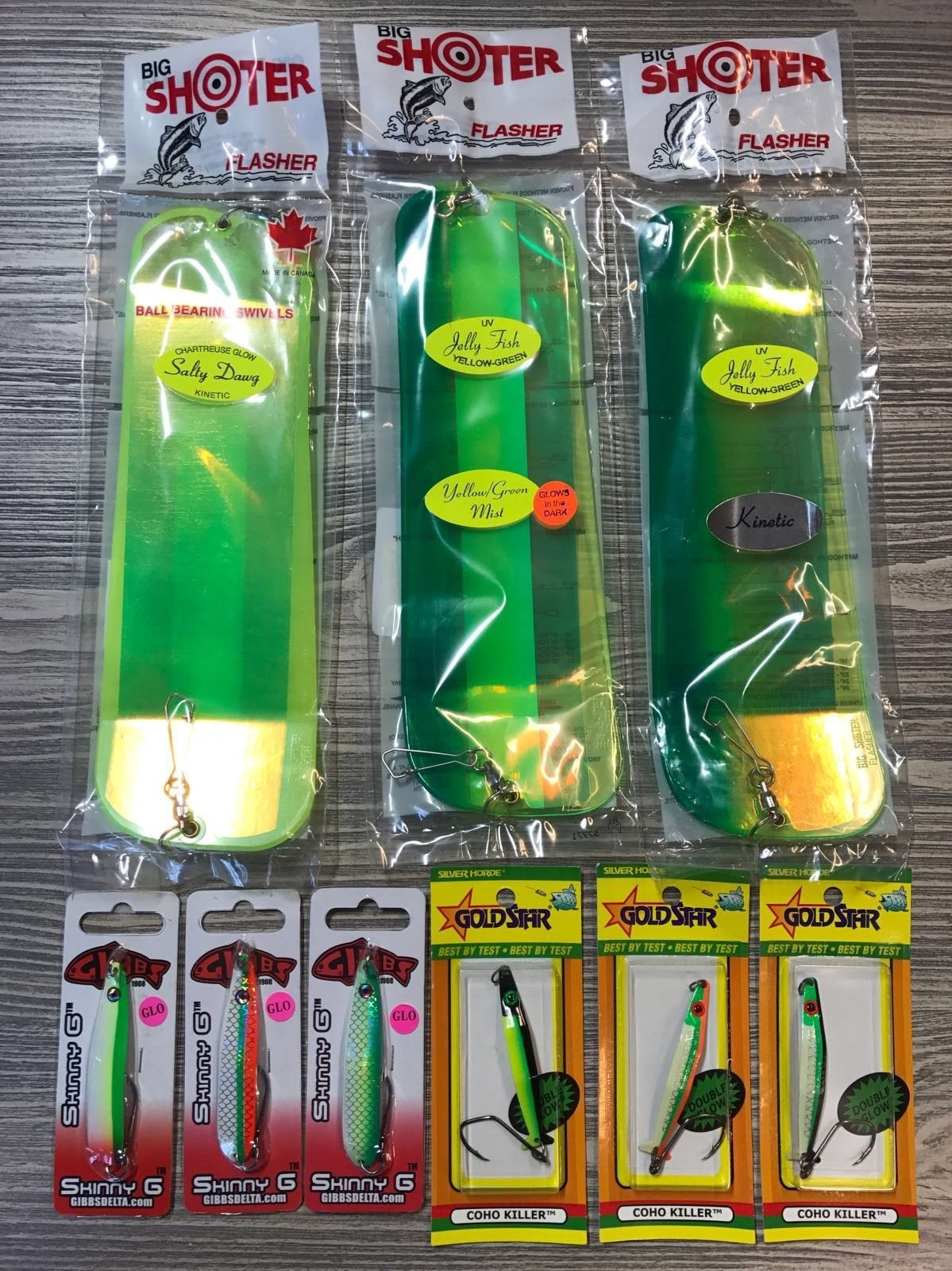OUTLOOK
Well the Christmas Season is upon us and the weather has not been bad for winter fishing – two things we love to see at the store. We try to keep the shameless product pitches to a minimum on the report so we wont get into Christmas shopping list or anything like that this week. I know our inboxes are exploding with product flyers right now but we do have a great new product line that hit the Pacific Angler floor. We are now a Mustang Survival dealer and have a great selection of 2017 and 2018 models in the store. We are stocking a number of different models that we feel offer a great spread of options and price points for fisherman and boaters so be sure to check out Friday Feature Product section below and learn about all the options that are available for floatation collars.
On the fishing front, though the fog has gotten in the way, the winter chinook reports have been good. Jason, Jordan and Eddie have all been out and we have details in this week’s Vancouver Saltwater Salmon Fishing Report.
As we eagerly await the first steelhead reports coming from the valley we have an in-depth look at how to set up leader boards for steelhead float fishing in the Vedder River report. It is still very early but it is time to get tying leaders and gearing up. Check out more info in the Vedder River fishing report below.
Though it is too early to be getting out with the fly rods for winter steelhead, we just released a new video on how Matt sets up his leaders off a sink tip for steelhead and bulltrout when swinging a fly. It is a basic video but a good review for intermediate anglers and a must see for new steelheaders. Check it out here. We will be releasing some more steelhead related fly-fishing videos over the next month so make sure you stay tuned on the fishing with Rod YouTube channel or on our media section on our website.
Matt also has his Squamish River report and though conditions are not perfect the outlook is good for this system over then next week.
Lastly we are going to wind down our reports on the Stave and Harrison systems over the next month but we have a good season overview for what you guys can expect coming in 2018 for these rivers.
FRIDAY FEATURE PRODUCT
Mustang Survival Inflatable PFDS
We are pleased to announce that we are now a Mustang Survival dealer! This is the leading brand when it comes to marine survival gear and we have selected some excellent PFDS that are perfect for your fishing and boating needs. We have a full selection of the new 2017 and 2018 models in stock! As this week’s feature product, they are on sale at 10% OFF, for 1 week only, Dec 8th to 15th. PFDS are great Christmas gifts for anyone that spends time on rivers, lakes or the ocean.
If you are looking for the ultimate in buoyancy and protection, then look no further than the HIT Inflatable PFD. This model uses award winning Hydrostatic Inflator Technology so it only auto inflates when submerged in more than 10 cm of water. This makes it perfect for severe weather like long days fishing in heavy rain or for serious sailing. Like all Mustang PFDS, you can pull the activation cord at anytime to inflate as well. It also boasts 38 lbs of inflation, more than twice the buoyancy found in standard foam PFDS and more than three times the amount of buoyancy needed to keep your head above water. It features a bright yellow inflation cell with SOLAS reflective tape and a safety whistle. MSRP $369.99 Sale Price $309.99
Next on the list is the DLX 38 Inflatable PFD. The automatic version of this PFD uses the traditional Mustang technology where the automatic PFD is activated when water enters the detector and dissolves a water-soluble trigger. This makes it a popular vest because when you fall in, conscious or not, it is going to get triggered and quickly. It also boasts 38 lbs of buoyancy and features a bright yellow inflation cell with SOLAS reflective tape and a safety whistle. For those of you that get wet a little more than the rest of us and don’t want your DLX 38 to go off by accident, we also have the manual version where you pull the activation cord to inflate.
Auto MSRP $320.99 Sale Price $279.99
Manual MSRP $279.99 Sale Price $239.99
If you are looking for lightweight and maximum flexibility than the M.I.T. 100 Inflatable PFD is the one for you. This PFD features Membrane Inflatable Technology to reduce weight and create a lighter, more flexible fit. This makes it a great choice where mobility is important such as paddling, rowing, and fly casting. It is available in automatic or manual versions and has 28 lbs of buoyancy, more than 1.5 times a regular foam PFD.
Auto MSRP $237.99 Sale Price $199.99
Manual MSRP $201.99 Sale Price $169.99
We also have the classic Inflatable Fisherman’s Vest. This vest is so comfortable and lightweight you might forget you’re wearing a PFD. Activated by manually pulling an activation cord, the inflatable vest is lighter and cooler than regular foam vests but still offers the same flotation performance. It is a great choice to wear over a t-shirt or warmer layers while lake or river fishing. This vest offers 16 lbs of buoyancy when inflated compared to 15.5 lbs of buoyancy in traditional personal floatation devices. It has six roomy storage pockets and a sheepskin fly patch combined with classic styling.
MSRP $304.99 Sale Price $249.99
If there are any other Mustang Survival pieces you are interested in, please let us know, as we are happy to assist and do special orders.
FRESHWATER FISHING REPORTS
Chilliwack River Fishing Report and How to Prepare Your Leader Boards
With Steelhead season fast approaching it’s important to be prepared. This week we released Matt’s video on how to set up a sink tip for fly fishing for steelhead and we have a very cool video about how to select steelhead flies that should drop around Christmas but the best way to target early steelhead is with a drift rod. So today we are going to look at steelhead gear setups and how to load your leader board so you are prepared for the different conditions that a steelhead season can throw at you.
There are an infinite amount of combinations one could put on their board but I will keep things basics for this report just as a base to get you started. I will talk about other options later in the report but these are five of the most useful set-ups I have on the go during steelhead season.
- The gooey bob is a great artificial imitation of roe; you can even add white wool to imitate a skein of roe. It’s great for rivers that have a bait-ban or if you want to cover water more quickly without having to re-rig bait every 10 or so casts. It’s good for moderate water levels that are the classic ‘steelhead green’ in colour as well as clearer conditions. In saying that there are a variety of gooey bob sizes to choose from that will fit both clear and murky conditions making them an efficient, clean, and versatile weapon of choice. It is also very common to add bait to the gooey bob when fishing a river system that allows bait. A chunk of prawn, a roe bag or cured roe in the bait loop below the gooey bob is a great option and smart because if the bait falls off you still have a great presentation on the line.
- The plastic or artificial worm works as an excellent follow-up lure when the fish just aren’t taking bait. The 4 and 6 inch versions in pink (any shade of pink really) are the classic but don’t be afraid to mix up the coloration. This is a great set-up for both clearer water as well as high and murky water depending on the length of the worm; 4 inch worms or smaller work better in clearer water while the 6 inch is perfect for high, murky water. We find that the worm shines when fish are aggressive. We see this early in the season and then again when the temperatures rise in the spring. It is also a go to after a big rain as real worms have been washed into the river.
- The single egg or bead set up is the most finesse set-up I have. Its best used in low water when the fish are easily spooked by larger unnatural presentations. It also can double as a bulltrout, rainbow, and cutthroat trout set-up especially early in the season when these hungry trout are gobbling up salmon eggs.
- The wool tie is my go-to drift fishing set-up and typically the first thing I’ll throw. It’s the easiest set-up I have and serves a dual purpose. I use it both as a cut egg pattern imitation and to fish my baits such as roe or shrimp. Wool retains scent very well and also has a natural skein-like movement in the water. It also helps to create an easy pull for the bait loop (which can get pretty sticky with bait residue) for faster re-rigging of your bait.
- The spin ‘n’ glow tie is another finesse presentation that adds vibration to make it an excellent multipurpose lure. It can be fished by itself or tied with wool, roe, or shrimp on the hook. Because of the finesse aspect I prefer to fish this set-up in lower clearer water but you can use larger sizes in slightly dirty water. A Spin ‘n’ glow paired with bait is a deadly combination of both vibration and scent.
As for the use of these set-ups, beyond water conditions, they vary depending on what time of the season it is. This early in the season there will be few fish, but the ones that are already in will be aggressive, as they haven’t seen much in the way of fisherman’s presentations. The real key is to cover water; presentation plays a part but it is most important to find where the fish are holding and get something in front of them. Furthermore, depending on where you’re fishing, sometimes change is the key. On rivers like the Vedder where there is a lot of fishing pressure it’s important to try new things or at least something different from what others are doing. Don’t be afraid to fish behind other anglers and use something considered to be unconventional. Change up the colour, size, or use an entirely different presentation.
With versatility and the ability to change fast a key to success, I rig my main line with a duo lock clasp and then tie all the presentations with a small black barrel swivel. This allows me to switch quickly without tying knots with cold fingers.
While these are the basic leaders that I’ll have on my board, this definitely is not a complete list of what you should be fishing when looking for steel. Other top producers (besides bait) are Colorado blades, float jigs, casting spoons and spinners; the list goes on. Just remember to change up once in a while and don’t be afraid of experimenting.
On to the actual report! We still haven’t heard or seen any confirmed reports of steelhead caught in either the Vedder or Chehalis but they are there; poor water conditions on the ‘Wack have most likely deterred many anglers from getting out there. We expect to hear of the first catches any day now and that could be from you! With the cooling trend and a lack of rain in the forecast, we should see some nice water coming up soon. The Chehalis has shaped up nicely so that is also a possibility; not to mention that that system has a late run of coho that is still going so you never know if that flash of chrome at the end of your line is going to be fresh steel or fresh coho. The Chehalis doesn’t get as many steelhead back as the Chilliwack but it can be productive later in the winter on the right day.
Alex Au-Yeung
Capilano River Fishing Report and 2018 Outlook
As soon as the water is released from the dam that will mark the end of the salmon fishing season of 2017 and the start of steelhead season on the Capilano River.
Once the water rises the first steelhead will start trickling in. We do not see many steelhead on the Capilano but it is a fishery worth looking at it you do not have time to travel farther. They can be targeted with spoons, spinners, flies, or drifting colorado blades, jigs, shrimp, roe and plastic worms but the most popular method for the high banked deep pools on the Capilano is with a gear rod and a float. Come talk to us and we will show you the right setups. Steelhead are expected to be in the system until mid-March.
After the steelhead fishery, around may we will see early Capilano coho come in. It’s a smaller run and the fish aren’t that big. However, they are known as one of the best-tasting coho. These fish usually shoot straight up as the water from the dam is released quite often. The best way to catch them is swinging cap buggers at the cable pool. You can also target the moving fish with spoons, spinners, or drifting with roe.
After the early coho season, the fall salmon season is upon us. Only a small amount of fish trickle in when the water is low. Most of the fish will stack at the mouth of the river and wait for the river to rise up. Once the water goes up, the river is filled with salmon. You can catch these salmon by casting lures, swinging flies, twitching jigs or drifting. Remember the bait ban comes into effect from August 1st until October 31st.
There is the overview of the 2018 season. Hopefully, everyone had an amazing year. Even if you didn’t let’s start thinking about what can be done better next year for a successful season.
Come in the shop and our knowledgeable staff will help you gear up for all the upcoming fishery.
See you on the river when the steelheads are in
Dustin Oh
Squamish River Fishing Report
I just want to start by thanking everyone for the response we got from last weeks Squamish report / rant. If you missed it here is a link to the report. In a re-cap I brought to light some concerns that I have about the fishery and though there are no easy solutions I laid out a few steps we as anglers can take to minimize our impact on this fishery.
It boils down to concerns over high water evens timed poorly with the spawning cycles of the salmon. Spawning habitat has been hit very hard this fall and we need to make sure we are not inadvertently stumbling through areas where salmon might have laid their eggs. I also want to stress how critical it is that we get involved with local organizations like the Steelhead Society to help them help the fish. If we want the Squamish River to have salmon for the next generation we have some work to do.
Though it is not going to change the fact that we had horrible blowouts last month, we did see some positive weather this last week. It was cool and not too wet. The river settled nicely all week. The reports that came in were also positive. There were quite a few late coho caught and the bulltrout fishing was solid.
Looking to this weekend and the next, the temperature is going to rise above seasonal norms. This should be good for fishing. Right now the river is getting low. The increase in temps should offset the impact of clear water and maybe encourage some snowmelt to keep the river from going gin clear. Time will tell but if you are out and the water is very clear, use pail colored beads and smaller streamer patterns or spoons for the late coho. I don’t expect this fishing to be lights out but I think it is still worth the trip.
In the long term forecast we have a little rain in a week and as long as it is not another massive storm this should turn on the fishing. As always you will want to be watching river levels and the weather channel.
We have lots of people coming in and asking about steelhead at least on the Squamish you will have very little success until the end of February. That said being prepared is great and this week we released a simple video on how I set up a sink tip and leader for swinging for steelhead. This is also the way I set up when swinging for bulltrout. Check it out and I will re-visit it when the steelhead reports start coming in.
Good luck out there,
Matt Sharp
Winter months on the Harrison and Fraser Rivers:
There are more fisheries available than just steelhead fishing in the winter months or if you just want to take a break and mix things up. If you can brave the cold on the Harrison River or the Fraser you can fish for resident cutthroat, white fish and the occasional dolly varden. After the salmon have spawned these fish will gorge on salmon eggs for awhile in the early part of December. If we experience a colder winter, river levels will drop to a extreme low levels and this could be quite good for walking the back channels and hunting for cutthroat. In the month of January when the eggs are already embedded on the bottom it is best to fish attractor patterns such as small woolly buggers in different colors and for those who fish gear very small spoons and spinners work best. The resident cutthroat that you might encounter are the pre -spawning fish meaning that they have not reached their cycle to migrate to the ocean before returning back to their native river to spawn. They are usually smaller than the ones called “sea-runs” that make they way up the creeks to get ready for spawning during the winter months. March and April is a magical time on the Harrison as the cutthroat migrate down from the spawning areas into the Harrison and the Fraser rivers to bulk up on salmon fry before heading down to the ocean for the summer months. Please handle these fish with care and release them gently as we are always trying to increase the population, as they are already hard to come by. If you are interested in this fishery we provide a course “Fly fishing for cutthroat” where you can get a more in depth understanding of this exciting fishery.
I will be back with more Harrison Reports mid to late February when things warm up so stay tuned and good luck if you get out on the water.
Andre Stepanian
Stave River Fishing Report and 2018 Outlook
The Stave salmon fishing has tapered off. It was a good season. We heard some great coho reports and consistent chum reports. There are still some salmon in the system, however, they are now quite stale and it is best to leave them alone on their spawning beads.
Another fishery we can take on is beading/egging for trout and whitefish. There are plentiful trout and whitefish in the system as they are gorging on eggs. If you drift with Jensen eggs, beads or egg-shaped wool in riffles behind spawning salmon, you can get these fish.
Steelheads are also trickling into the system. Over the next few months, we will be able to catch them by drifting with steelhead rigs such as plastic worm, gooey bob, corkies, colorado blades or spin-n-glos. You can also use roe or shrimp. Fly fishing is also a viable option; try steelhead patterns in different colours.
The egg fishing trout fishery will last until mid February and steelhead will be in the system from now until May.
At the end of the steelhead season, we will see another trout fishery in the stave river. Fly fishing with fry pattern or tossing little spoons or spinners will attract the trout that are in the system to feed on the salmon fry. This fishery goes from March to May. The river usually gets high in May and though there are still resident fish in the system all summer it is not a go to destination until fall.
Early September marks the start of the salmon fishery. Once the chum salmon start coming in you can expect to hook them left and right because there are so many. Drift with jigs and if they don’t bite, play with your depth a little bit. Coho salmon will show up as well and they can be targeted with flies, spoons, or spinners. Look for frog water or structures when looking for coho as they like slow moving water.
That sums up the 2018 overview of the Stave river. If you wish to try any of the fisheries mentioned above, come to the shop and we will be glad to help.
Stay warm on the water,
Dustin Oh
SALTWATER FISHING REPORTS
Vancouver Saltwater Salmon Fishing Reports
If you have some time off in December for Christmas Holidays, have some friends in town, or are just here visiting, I would suggest getting out for some winter chinook fishing. It has been about a month now since the winter season really got rolling and so far, so good. In fact there have been some down right awesome days out there with good numbers of chinook coming back to the dock. Even on the slower days there has been decent action with smaller chinook to keep the rods bouncing and a few long line releases on bigger fish. To top it off, crabbing and prawning has also been productive. So if you want some fresh air or want to cure that cabin fever after all the rain, give us a call to book a winter chinook trip!
If you are heading out on your own boat remember to keep your gear close to the bottom. We are often fishing in 100-250 feet of water, very close to bottom, so make sure you have lots of cable or braid on your rigger, at least 300 feet. Also try using 18 pound cannonballs instead of 15 pound cannonballs once you are down past 175 on the riggers. This will help keep your gear down in the zone when you are fishing deep and also helps when the tidal current is strong.
Keep in mind the water is very clear this time of year so UV and glow flashers will work well. Generally when we are fishing 100-175 feet the UV flashers will work very well. Once you get down to 175-250 feet flashers with glow will start to produce better. The same can be said for spoons. When fishing shallower try non-glow spoons and once you get deep make sure the spoon has glow paint on it. You can also use anchovies in teaser heads, UV, or glow, but this time of year trolling fast with spoons and covering water tends to work as good or better than bait. It is also important to match the bait size and this time of year it is usually pretty small. That means small spoons like Gibbs’ Skinny G and Silver Horde’s Coho Killer.
Below is a picture of some very productive flashers and spoons for winter chinook in our local waters. The first flasher on the left is the Salty Dawg. This flasher has a chartreuse glow blade with an extra piece of glow tape on one side and chartreuse reflective tape on the other side. This is an excellent choice when fishing deep. The flasher in the middle is the UV Jelly Fish Yellow Green Mist with a glow stripe, aka Club Dub Glow. This is a killer flasher without the glow stripe, but the glow stripe gives it a bit more pop when fishing 150-225. The flasher on the far right is the original UV Jelly Fish Yellow Green Mist, aka Club Dub. From the surface down to about 175 this is a go to flasher that has caught a lot of fish over the last few years. With these 3 flashers you will have all depths covered. Below the flashers are some go to Skinny G and Coho Killer spoons that represent the winter anchovies and herring very well. Give these flashers and spoons a try and you won’t be disappointed.
See you in the shop or on the water,
Jason Tonelli











